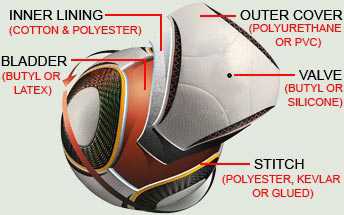Welcome! Click here to
toll free
1-866-207-3179
Identify what materials are used for the different parts of a soccer ball

Do you plan to buy a soccer ball? Knowing the materials used to make a soccer ball will help you choose the right one. There are different materials for the outer cover (A), inner lining (B), bladder (C), stitch (D), and valve (E).
A. Outer Cover: Polyurethane (PU) or PVC
The outer cover is the outermost part of a soccer ball, which protects it from wear and gives the ball its appearance.
Traditionally, the material for the outer cover is made of pure leather. But leather has poor water resistance and gets heavy in wet playing conditions. In the 1970s, soccer ball manufacturersbegan coating leather with polyurethane, a synthetic material, to protect the ball from damages like scuffs and scratches. It also made the ball playable even on wet weather.
The outer cover of modern soccer balls are made of synthetic leather for enhanced water resistance. Synthetic leather (coated with polyurethane) is the material for soccer balls used at professional and top-flight level because it has the best feel for the ball.
PVC is another material used for outer cover. This plastic-like material is highly durable but offers less feel for the ball. PVC covers are also hard, which do not make them ideal for playing.
The cover for an indoor soccer ball is made of a material called felt, the same material that coats a tennis ball. Felt makes the ball more controllable on smooth surfaces.
B. Inner lining: Cotton & polyester
The inner lining is located between the bladder and the outer cover. The material it is made of determines how bouncy or how responsive a ball is.
Professional soccer balls, such as the ones used in the World Cup, have inner linings made of multiple layers. Often, they have four layers of polyester and cotton. Cotton gives softness to the ball while polyester makes it durable and responsive.
Cheap footballs only have two layers of polyester for inner lining. These balls are still durable but they are harder and more difficult to control.
C. Bladder: Butyl or latex
The bladder is the part of the soccer ball which holds air.
The most common bladder material is butyl because it is durable and retains air very well. Butyl's disadvantage is that it is easily deformed so it is less responsive when kicked.
Latex is the preferred material in professional level because of its responsiveness. The problem with a latex bladder is that it easily loses air so it has to be filled regularly. Also, it is not as durable as butyl.
Indoor soccer and futsal (Futsal) balls have their bladders filled with foam instead of air to reduce bouncing.
D. Stitch: Polyester, Kevlar or glued by thermal eating
Stitches hold the panels of a soccer ball together.
The panels on a professional soccer ball are mostly stitched with polyester, a durable, non-absorbent material. Kevlar thread can be also used for enhanced durability and water-resistance.
Some football balls these days are no longer stitched. Instead, the panels are glued together using thermal heating. These balls are now the norms in international competitions such as the 2010 FIFA World Cup because the absence of stitches makes the ball smoother and more accurate.
E. Valve: Butyl or silicone
The valve is the part of a soccer ball where air passes through when inflating it. It is a needle-like structure which looks like a tiny hole from the outside.
Soccer ball valves are typically made of butyl, a rubber material that easily opens when the air pump needle is inserted. Because of its elasticity, it quickly closes when the pump is removed.
Many professional football balls these days have silicone valves for better air retention.




